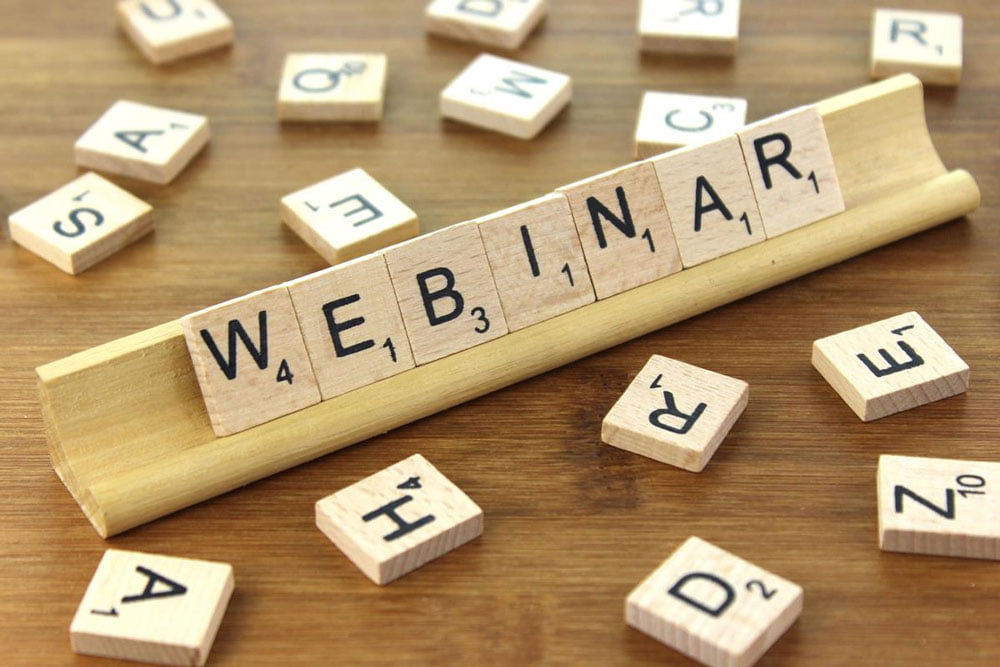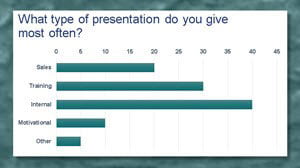Why Webinars are Great and How to Design Them Effectively


More and more presentations these days are given via webinar instead of with a live audience in the same room as the presenter. If you haven’t given a webinar yet, we see one in your future. Why? Ellen Finkelstein answers that question and shows how careful thought to their design is crucial to their success.
Why should you give a webinar?
With webinars, you can reach more people – all over the world. A few years ago, I organized a series of webinars that had over 3,000 people from 98 countries registered! Here are some other reasons to give webinars. You can:
- Reach people who can’t travel to your location
- Save money on travel expenses
- Record the event and make it available to people who missed it or post it online permanently
- Deliver e-learning courses
- Record a sales video that you want to post online
- Create a series of webinars, each with a different speaker
- Follow-up more easily with the audience members
Why are webinars different from live presentations?
Besides the obvious difference that the audience isn’t in the same room as you, there are a number of differences that mean you need to present differently.
During your first webinar, you’ll need to adjust to the fact that you don’t see your audience when you give a webinar. Initially, this is very disconcerting! Are they there? Are they listening?
The following important differences between webinars and live presentations will explain why you need to present and follow up differently for a webinar (and later, I’ll explain some ways to make up for that disconnect with interactive features).
1) Your audience can multitask much more easily
When your audience is in the same room as you, they can peek at their phone, but they do it surreptitiously because they know it’s impolite. And aside from that, there’s not much else they can do.
When your audience knows that you can’t see them, they’re much more likely to check their phone. Also, there are many other things they can do. They can use their computer to browse the Internet, check their email, or play Free Cell. They can also easily get up for some coffee.
And, if you don’t create a compelling experience, they will.
2) The webinar technology isn’t high-definition
As a result, animation on your slides does not look good; anything that moves fast will get pixelated or blurry. Also, there is a slight delay between what they hear and what they see. (On some platforms, like YouTube Live, this delay is significant.)
3) Follow-up is online
Follow up is actually easier for a webinar than for a live presentation because you have the email address of everyone who registers. Since not everyone who registers will attend, you need to send registrants the recording. Even some people who attend the live webinar may want to watch the recording. You can continue to send people emails about the topic of your webinar.
9 principles of designing presentations for webinars
So, how do you make up for these differences? Here are 9 principles you can use. These points are taken from a live presentation I gave at the Presenters Network meeting in Manhattan.
By the word “design,” I mean the design of the slides, the content, and your follow-up.
1) Use and design for the webcam
The webcam lets people see you, like they would in a live presentation. This helps create more engagement. Your audience gets to know you–and hopefully like you. Simply put, it’s more like a live presentation. Try to come into their living room or office!
If the webinar platform you’re using puts the webcam where it might cover your slides, leave a space on the slides for it.
But because you don’t have to use the webcam, webinars are great for introverts and poor speakers. You can print out your script and use it. I don’t recommend hiding behind the slides, but most people do.
Funnily enough, this recommendation to use the webcam is controversial. Some people say the webcam is distracting. I ask, why is it more distracting than people seeing you in a live presentation?
In fact, when you tell a story, you can turn off screen sharing and show only the webcam in some webinar programs. This is equivalent to pressing the B key you your screen in a live presentation to black out the screen and turn the audience’s attention to you.
2) Use the interactive features
You need to take steps to engage your viewers so that they don’t multitask. One way to do this is to use the interactive features of webinars:
- Chat box: Ask viewers questions and let them ask questions in the chat box. You can read out viewers’ answers and answer their questions verbally.
- Polls: Use polls to inform yourself about the audience and to inform the audience about the views of other audience members. Note that not all webinar software records the polling window.
- Whiteboard: You can write on the screen to emphasize points. This includes pointing to areas on the screen and circling items. Note that you can also use PowerPoint’s animation to accomplish a similar effect more neatly, but the live scribbling does engage the audience.
Tell people at the very beginning that the webinar will be interactive and that you want them to participate, not just listen. This puts your audience in a different frame of mind and will keep them more attentive.
You can offer prizes to audience members who share their own views. If you state this in advance and show a slide with the prizes, you’ll get more participation. Prizes should be electronically deliverable, such as an e-book or an online gift certificate. You can even announce a grand prize, such as a 30-minute consulting session with you at a later date.
One technique to keep people from logging off early is to announce at the beginning that you’ll be giving a free gift or handout to people who stay. Then give them the link near the end.
As with any presentation, you should do change ups regularly—but more often during a webinar. Depending on your topic and audience, you might:
- Ask questions
- Ask for questions and answer them
- Do a mini-workshop
- Do a poll
- Tell a story or give an example
- Do a demo
For example, since you should be on the webinar before the official start time, you can ask attendees who joined early to put their name and location in the chat box and you can start an informal discussion with them. Attendees always like to know where other attendees are from.
You can ask them what they’re hoping to get from the webinar – and then incorporate that information into your content.
Some webinar programs have breakout rooms, which let people in the audience go into small groups and have a discussion or do an exercise. You can also ask for volunteers from the audience to share a point and then elevate them to panelist status so they can show their webcam (if they want) and speak.
You need to be more interactive when people are not in the same room with you or you’ll lose their attention.
3) Use more slides
To keep the webinar lively, use more slides. I recommend at least 2 per minute. Of course, some webinars are technical and content heavy, so use your judgment. If you’re a market researcher and have been asked to present your research so executives can decide whether to launch a new product, you’ll need to provide detailed data and will probably spend more time on each slide than you would if you’re an inspirational speaker.
A simple way to use more slides is to divide up your current slides, putting less content on each slide. Of course, you’ll spend less time on each slide, so your overall presentation time won’t change.
4) Force the audience to look at the slides to understand your point
Design some slides so that they’re essential to the understanding of your presentation. This technique can prevent people from half listening while they scroll through Facebook.
As an example, you could say, “What you see on this slide explains the process clearly.” This brings your multitaskers (if they’re listening at all) back to your slides. A process diagram would work well to accomplish this.
5) Text and images don’t have to be as large, but…
When your presentation is projected on a screen and people at the back of the room need to see it, text and images needs to be quite large. In a webinar, your audience is right up close to their computer screen so your text and images can be smaller, as on a website (like this one).
However, big and bright will keep their attention so don’t use the close-up situation as an excuse to create boring slides. As always, graphics should be relevant, not decorative, so that they help the audience understand and remember your points.
6) Animation does NOT display well
![]()
![]()
There’s often a short lag between what you do and when the audience sees it. If you use a lot of animation, what you’re saying and what your audience is seeing will become out of sync causing confusion and frustration.
The solution is to keep animation simple and clean. For example, use the Appear animation instead of the Fade animation and don’t apply several animations quickly in succession.
Avoid slide transitions because they will just annoy your audience. Just say no.
7) If people don’t know you, introduce yourself first
In a public webinar, it’s more likely that people won’t know you, so go ahead and introduce yourself at the beginning.
But if they do know you — whether you’re speaking to people in your company or even to prospective clients who know who you are — don’t bore your audience at the beginning with your biography. Which often goes on and on and on…
Your audience wants you to get to the good stuff quickly in any presentation, but on a webinar, if you lose them at the beginning, you’ll never get them back.
8) Vary your pitch and tone


I recommend that you stand up for a webinar just as you would for a live presentation. Standing gives you more energy and helps you project your voice better. I use a stand-up desk, which makes it easy for me to stand when I give a webinar.
Some webinar presenters put photos of friends around the computer screen so they can imagine that they’re talking to real people.
If you have a script — and you should — don’t read it word for word. You’ll sound like a robot! You accomplish this by practising. Record your practice and you’ll know right away if you need to work on how your voice sounds.
Once you’re familiar with what you’ll say, you can use notes or phrases to guide you so that you aren’t reading verbatim.
9) Follow up immediately and regularly
As I mentioned earlier, one of the great advantages of webinars is the ability to easily follow up with your audience. You can ask them for feedback and post the recording so people who didn’t make the webinar can still watch. You should send out an email with the link to the recording as soon as possible after the webinar.
In most cases, when people register for a webinar, you can add them to your email list. I recommend that you make it clear when they register. For example, GoToWebinar adds a phrase like this, “By clicking this button, you submit your information to the webinar organizer, who will use it to communicate with you regarding this event and their other services.”
If you use webinars to grow your email list and active email subscribers, you should send webinar registrants a welcome email so they have an idea of what to expect from you. This will reduce the number of unsubscribes that you get.
The opportunities are endless
I’m a big fan of webinars. In my experience, you can reach more people in more places than you could ever manage with speaking to live audiences. If you use the webcam and interactive tools, you can come close to approximately the experience of a live event. I’m sure you have an important message, so go out and change the world!
If you are inspired to do your first webinar, you’ll find much more information at the Presentation Guru’s guide to 10 of the best tools for hosting a webinar and 5 free ways to broadcast a webinar or live presentation.















